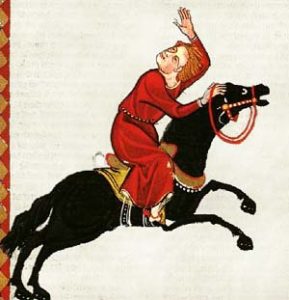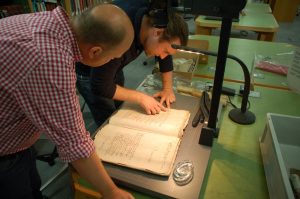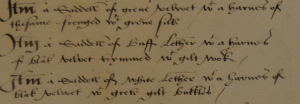What sorts of records are available that allow us to investigate the horses – in particular warhorses – of medieval and Tudor England? Dr Gary Baker, Senior Research Associate on the ‘Warhorse: The Archaeology of a Military Revolution?’ project explains all.

Horses were an everyday part of life in medieval and Tudor England and were used for a multitude of purposes: transport, communication, agriculture, hunting, racing, and, of course, war. Indeed, the armoured knight on horseback is the most evocative image of the Middle Ages in the popular imagination. Tens of thousands of horses of all shapes and sizes were utilized by the English at war from the Welsh and Scottish campaigns of Edward I to the wars of Elizabeth I, from the great and expensive destriers favoured by royalty and the nobility to the everyday rounceys of men-at-arms and mounted archers and the humble pack horse, which lumbered in the baggage train.
The feeding, welfare, upkeep, breeding, buying and selling, and stabling of horses, as well as the recruitment and arming of men and horses for war, has generated a massive corpus of documentary material in the surviving records of medieval and Tudor England. These records were generated at both a national and local level, and are scattered in numerous archives. Alongside the physical remains of horses and their accoutrements, this blog post highlights some of the key sources and most prominent record series (and the type of information they provide), that the team on the AHRC Warhorse project are utilizing to explore the warhorse in medieval and Tudor England.
Professor Robert Liddiard (left) and Dr Gary Baker (right) examining a sixteenth century account at the UK National Archives
Equitium Regis Accounts

A box of equitium regis accounts at The National Archives (right)
These royal stable (equitium regis) accounts are housed in the The National Archives UK (TNA), enrolled on the series E 372 pipe rolls (the particulars of which are contained in series E 101). They contain details of the management and expenses incurred by the royal stables and king’s studs. They date from the late thirteenth century until the reign of James I, and were compiled and sent to the Exchequer by the Keepers of the King’s Horses north and south of the River Trent, and, from the end of the fourteenth century, by the Master of the Horse. Some accounts consist of only a single folio whilst others are several membranes long.
The contents of these accounts include payments and expenses for provisions for the horses, equipment, stabling, the sale and purchase of beasts, and the number of animals under officials’ care. There are also miscellaneous entries such as the provision of livery for horses of noblemen visiting the royal household, and purchases for some medical expenses and healthcare for the horses.
Detail of TNA E101/97/2, account of the royal stud at Chester (1283–4) including purchase of cut grass (herba) for nineteen of the king’s horses and one of the queen’s mounts.

Horse Appraisal and Restauro Equorum accounts
These two inter-related sets of accounts, dating from the reigns of the first three Edwards (1290s to 1360s), are a unique survival of an important period of the development military service. They are located primarily within TNA E101, though some can be found in other documentary series. As part of the terms of service agreed between the Crown and men-at-arms, the Crown agreed to assess the value of a horse of a man-at-arms and pay the soldier compensation if his mount was lost on campaign. The horse appraisals are lists of warhorses appraised by the royal commissioners prior to campaign, and provide the name of the mount’s owner, the type of horse being appraised, a brief description of the beast (in terms of its colouring and distinctive features), and monetary value. The restauro equorum accounts are the sister documents to the horse appraisals, listing horses which had previously been assessed and denoting that they had been killed on campaign and the value paid to their owner in compensation.
Detail of E101/14/15 m.2 showing horses assessed for service in 1314 headed by Sir Andrew de Harcla: ‘Dominus Andreas de Harcla habet unum dextrarius peys pomele precii – XX libras’; ‘Master Andrew de Harcla has one destrier, pied spotted, price of £20’.

Private and Manorial Accounts
Manorial accounts are some of the most varied and numerous documents in existence in medieval and early modern England, and concern the business and administration of the manor. Accounts of stabling and the upkeep of horses can often be found, but there is not standard documentation, with content varying from manor to manor. Some are quite extensive, such as the Winchester Pipe Rolls, the most complete set of manorial accounts in existence, dating from 1208–9 in an almost unbroken series to 1710–11. Private household accounts are often just as fruitful, containing information about the administration of the household and its affairs.
Detail of E101/93/20 (1357-9) showing the purchase of hay for 38 horses and 5 hackneys in the household of Elizabeth de Burgh, Lady Clare
Accounts of Royal Works
These are records of the Clerks of the King’s or Queen’s Works, the Surveyors of Works, and constables of royal castles. As their name suggests, they relate to works and repairs to royal properties. Though not specifically focused upon horses and stables they certainly provide important details related to the use and stabling of these animals.
Detail of E101/458/9 f.2v, (1537–8) a description of the stables in the east ward of Barnard Castle, County Durham, which is ‘is decayed in diverse places’.

Miscellaneous Documents
As mentioned earlier, the sheer amount of records of horses and warhorses generated in medieval and Tudor England has meant that there are thousands or records that do not readily fit within neat categorizations. Often this is because the documents in question were not compiled specifically for the purpose of recording information on horses but note them in passing. The nature and benefit of such records is that they sometimes provide details about horses and their equipment which more rigidly structured official accounts do not. One such type of sources are inventories of the goods of deceased persons. In 25 July 1536, for example, John Gostwyk compiled an inventory of the goods of Henry VIII’s illegitimate son Henry FitzRoy, Duke of Richmond and Somerset, who had died two days earlier, including the contents of his stable.[1] He possessed four horses (a jennet[2], a black, a bay, and a sorrel),[3] a little mule, two other mules, six geldings, and three nags, with several saddles including one of green velvet with a harness of the same fringed with green silk, another of buff leather with a harness of black velvet trimmed with gilt work, and a third of white leather with a harness of black velvet with great gilt buckles.
Detail of inventory of the goods of Henry FitzRoy, Duke of Richmond, 1536 (British Library Royal MS 7 F XIV f. 99r).

Wills are another excellent source of information on horses and their role in society. Horses and horse equipment were often prized and valuable goods and bequeathed to close family members and associates. Edward, Duke of York, who died at Agincourt in 1415 made his will during the siege of Harfleur on 17 August. He left to John Popham of Hampshire, ‘my new brigandines of red velvet … the bascinet that I wear and my best horse’ and ordered that his saddles and harnesses be equally divided amongst the members of his retinue, ‘except that I wish that Rokell [one of the duke’s household archers] should have the best’.[1] Over three centuries later in 1633, Phillip Weath the rector of Hinderwell in Scarborough, North Yorkshire, bequeathed to his wife Elizabeth ‘my Nagg Andrewe to ride on’.[2]
Detail from Will of Phillip Weath, 1633

The above highlights only a fraction of the source materials the team on the AHRC Warhorse project are looking to investigate. We hope to provide more interesting information as we find it in the coming months.
Dr Gary Baker is the Senior Research Associate on the AHRC warhorse project, currently working at the University of East Anglia.
Notes
[1] Baker, G. ‘To Agincourt and Beyond! The Martial Affinity of Edward of Langley, Second Duke of York (c.1373–1415)’, Journal of Medieval History 43:1 (2017), p. 50.
[2] York’s Archbishops Register: Entry 1, Register 32 f.29 (verso) entry 1 <http://https://archbishopsregisters.york.ac.uk/entry/s7526f70g> [Accessed: 23 Sep 2019]
[1] BL Royal MS 7 F XIV, ff. 83r–99v.
[2] A small Spanish horse.
[3] Chestnut.
